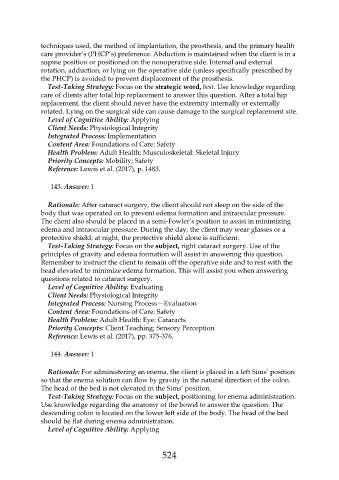Page 524 - Saunders Comprehensive Review For NCLEX-RN
P. 524
techniques used, the method of implantation, the prosthesis, and the primary health
care provider’s (PHCP’s) preference. Abduction is maintained when the client is in a
supine position or positioned on the nonoperative side. Internal and external
rotation, adduction, or lying on the operative side (unless specifically prescribed by
the PHCP) is avoided to prevent displacement of the prosthesis.
Test-Taking Strategy: Focus on the strategic word, best. Use knowledge regarding
care of clients after total hip replacement to answer this question. After a total hip
replacement, the client should never have the extremity internally or externally
rotated. Lying on the surgical side can cause damage to the surgical replacement site.
Level of Cognitive Ability: Applying
Client Needs: Physiological Integrity
Integrated Process: Implementation
Content Area: Foundations of Care: Safety
Health Problem: Adult Health: Musculoskeletal: Skeletal Injury
Priority Concepts: Mobility; Safety
Reference: Lewis et al. (2017), p. 1483.
143. Answer: 1
Rationale: After cataract surgery, the client should not sleep on the side of the
body that was operated on to prevent edema formation and intraocular pressure.
The client also should be placed in a semi-Fowler’s position to assist in minimizing
edema and intraocular pressure. During the day, the client may wear glasses or a
protective shield; at night, the protective shield alone is sufficient.
Test-Taking Strategy: Focus on the subject, right cataract surgery. Use of the
principles of gravity and edema formation will assist in answering this question.
Remember to instruct the client to remain off the operative side and to rest with the
head elevated to minimize edema formation. This will assist you when answering
questions related to cataract surgery.
Level of Cognitive Ability: Evaluating
Client Needs: Physiological Integrity
Integrated Process: Nursing Process—Evaluation
Content Area: Foundations of Care: Safety
Health Problem: Adult Health: Eye: Cataracts
Priority Concepts: Client Teaching; Sensory Perception
Reference: Lewis et al. (2017), pp. 375-376.
144. Answer: 1
Rationale: For administering an enema, the client is placed in a left Sims’ position
so that the enema solution can flow by gravity in the natural direction of the colon.
The head of the bed is not elevated in the Sims’ position.
Test-Taking Strategy: Focus on the subject, positioning for enema administration.
Use knowledge regarding the anatomy of the bowel to answer the question. The
descending colon is located on the lower left side of the body. The head of the bed
should be flat during enema administration.
Level of Cognitive Ability: Applying
524

